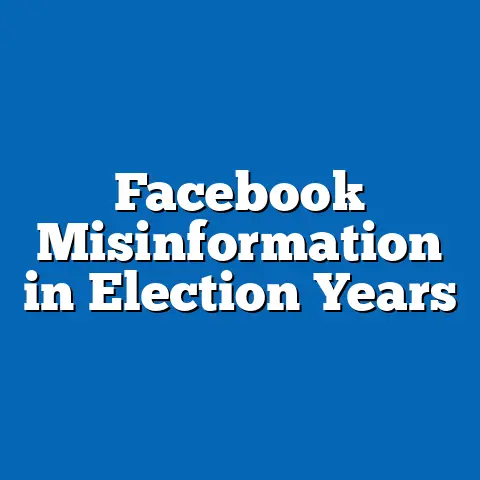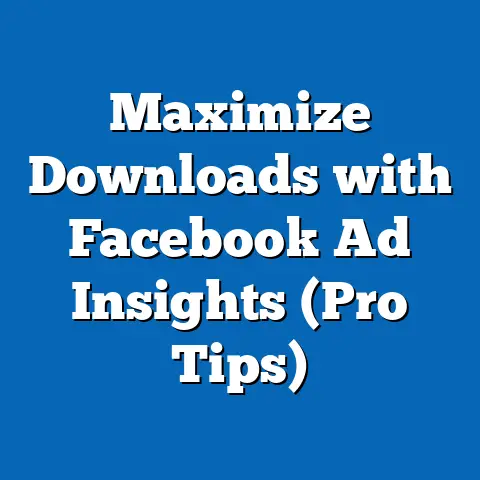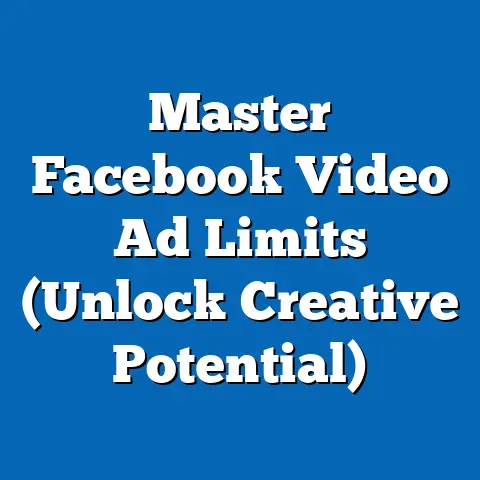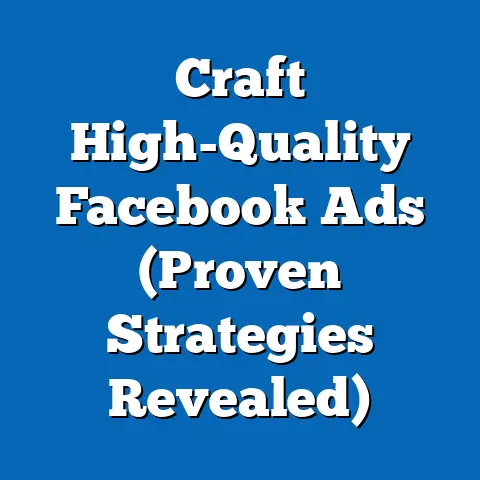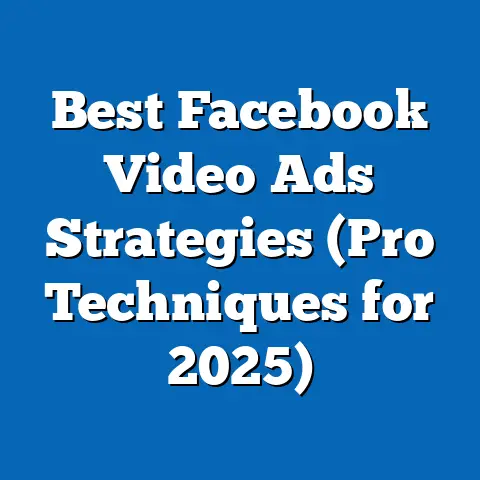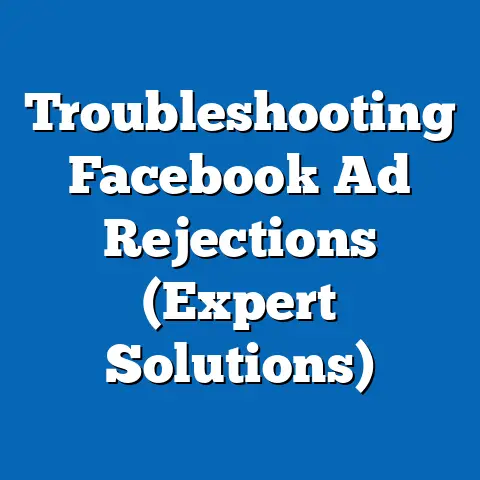Navigate Facebook Ad Restrictions (Essential Tips Revealed)
Navigating Facebook Ad Restrictions: Essential Tips Revealed
Have you ever poured your heart and soul into crafting the perfect Facebook ad campaign? You’ve meticulously chosen the visuals, agonized over the copy, and targeted your ideal audience. You click “publish,” brimming with anticipation, only to be met with the dreaded message: “Ad Rejected.” The feeling is deflating, isn’t it? I’ve been there, staring at that red notification, wondering what went wrong and how much potential revenue I was missing out on. The truth is, dealing with Facebook ad restrictions can feel like navigating a minefield. But don’t worry, you’re not alone! And more importantly, these setbacks don’t have to define your Facebook advertising journey.
Understanding Facebook ad policies is the key to turning these potential pitfalls into success stories. I’m going to share essential tips and strategies to help you navigate the complex world of Facebook ad restrictions, ensuring your campaigns not only get approved but also drive the results you’re looking for.
Understanding Facebook Ad Policies
Facebook ad policies are the comprehensive set of rules and guidelines that govern what is and isn’t allowed in advertising on the platform. Think of them as the “rules of engagement” for advertising on Facebook and Instagram (which are both under Meta’s umbrella). These policies cover a wide range of topics, from the types of content that are prohibited (like hate speech or misleading information) to the technical specifications for ad creatives.
Why do these policies exist? Well, Facebook’s primary goal is to provide a positive and safe experience for its users. By enforcing these policies, Facebook aims to prevent ads that are deceptive, offensive, or harmful from reaching its audience. Imagine the platform if there were no rules – it would be flooded with scams, inappropriate content, and ads that exploit vulnerable users. No one wants that!
Adhering to these policies isn’t just about avoiding rejection; it’s about building a sustainable and successful advertising strategy. Think of it this way: if you consistently violate the rules, you’re essentially building your house on sand. Your campaigns might get approved temporarily, but you’re always at risk of being penalized.
The consequences of violating Facebook ad policies can range from ad rejection to account suspension, or even permanent ban from the platform. I’ve seen businesses lose access to their advertising accounts, crippling their marketing efforts and impacting their bottom line. It’s crucial to understand that Facebook takes these violations seriously.
Takeaway: Facebook ad policies are in place to protect users and ensure a positive experience. Adhering to these policies is essential for the long-term success and stability of your advertising efforts.
Common Reasons for Ad Rejections
Understanding the reasons behind ad rejections is the first step towards creating compliant and effective campaigns. Here are some of the most common culprits:
-
Misleading Content: This is a big one. Facebook cracks down hard on ads that make false claims, exaggerate results, or deceive users in any way. This includes misleading headlines, clickbait, and unrealistic promises.
- Example: An ad for a weight loss product that claims “Lose 20 pounds in a week without diet or exercise” is a clear violation of this policy.
-
Inadequate Targeting: Facebook requires ads to be targeted to users who are likely to be interested in the product or service being advertised. This means you can’t discriminate based on sensitive attributes like race, ethnicity, religion, or sexual orientation.
- Example: An ad for a housing opportunity that excludes certain demographic groups violates Facebook’s non-discrimination policy.
-
Prohibited Content: This category includes a wide range of content that is explicitly banned by Facebook, such as:
- Adult content: Ads that are sexually suggestive, exploit, abuse, or endanger children.
- Hate speech: Ads that attack or dehumanize individuals or groups based on protected characteristics.
- Illegal products or services: Ads for illegal drugs, weapons, or other prohibited items.
- Misinformation: Ads that spread false or misleading information about important topics like health or elections.
-
Non-Compliance with Community Standards: This refers to content that violates Facebook’s overall community standards, such as bullying, harassment, or violence.
- Example: An ad that promotes violence or incites hatred against a particular group is a direct violation of Facebook’s community standards.
Misleading Content: This is a big one. Facebook cracks down hard on ads that make false claims, exaggerate results, or deceive users in any way. This includes misleading headlines, clickbait, and unrealistic promises.
- Example: An ad for a weight loss product that claims “Lose 20 pounds in a week without diet or exercise” is a clear violation of this policy.
Inadequate Targeting: Facebook requires ads to be targeted to users who are likely to be interested in the product or service being advertised. This means you can’t discriminate based on sensitive attributes like race, ethnicity, religion, or sexual orientation.
- Example: An ad for a housing opportunity that excludes certain demographic groups violates Facebook’s non-discrimination policy.
Prohibited Content: This category includes a wide range of content that is explicitly banned by Facebook, such as:
- Adult content: Ads that are sexually suggestive, exploit, abuse, or endanger children.
- Hate speech: Ads that attack or dehumanize individuals or groups based on protected characteristics.
- Illegal products or services: Ads for illegal drugs, weapons, or other prohibited items.
- Misinformation: Ads that spread false or misleading information about important topics like health or elections.
Non-Compliance with Community Standards: This refers to content that violates Facebook’s overall community standards, such as bullying, harassment, or violence.
- Example: An ad that promotes violence or incites hatred against a particular group is a direct violation of Facebook’s community standards.
Let me share a personal experience. I once ran an ad campaign for a client selling online courses. The ad copy was a bit too enthusiastic, promising “guaranteed success” and “life-changing results.” The ad was promptly rejected for making misleading claims. I learned my lesson: it’s always better to be realistic and transparent in your advertising.
Takeaway: Be mindful of these common pitfalls and carefully review your ads before submitting them. Avoid making exaggerated claims, ensure your targeting is appropriate, and steer clear of prohibited content.
Key Strategies to Navigate Restrictions
Now that we’ve covered the basics and common pitfalls, let’s dive into some practical strategies you can use to navigate Facebook ad restrictions and get your campaigns approved.
1. Thoroughly Review Facebook’s Advertising Policies
This might seem obvious, but it’s worth emphasizing: read the policies! I know, it’s not the most exciting task, but it’s absolutely essential. Facebook’s advertising policies are a living document, meaning they are constantly being updated to reflect new trends, technologies, and societal concerns.
The best way to access and navigate these policies is through the Facebook Business Help Center. You can find a comprehensive overview of all the policies, along with detailed explanations and examples. I recommend bookmarking this page and checking it regularly for updates.
Tip: Pay close attention to the sections that are most relevant to your business. For example, if you’re advertising health products, be sure to review the policies related to health and wellness claims.
2. Crafting Compliant Ad Copy
Your ad copy is one of the most important factors in determining whether your ad gets approved. Here are some guidelines to follow:
-
Be clear and concise: Avoid using ambiguous language or making vague promises. Clearly state what you’re offering and what users can expect.
-
Avoid making unsubstantiated claims: Back up your claims with evidence or disclaimers. If you’re claiming that your product is “the best,” be prepared to provide supporting data.
-
Use appropriate language: Avoid using offensive, discriminatory, or inflammatory language. Be mindful of the tone and language you use, and ensure it is respectful and inclusive.
-
Don’t exploit sensitive topics: Avoid using tragedies, crises, or other sensitive events to promote your products or services.
-
Comply with legal requirements: Ensure your ad copy complies with all applicable laws and regulations, such as those related to data privacy and consumer protection.
Be clear and concise: Avoid using ambiguous language or making vague promises. Clearly state what you’re offering and what users can expect.
Avoid making unsubstantiated claims: Back up your claims with evidence or disclaimers. If you’re claiming that your product is “the best,” be prepared to provide supporting data.
Use appropriate language: Avoid using offensive, discriminatory, or inflammatory language. Be mindful of the tone and language you use, and ensure it is respectful and inclusive.
Don’t exploit sensitive topics: Avoid using tragedies, crises, or other sensitive events to promote your products or services.
Comply with legal requirements: Ensure your ad copy complies with all applicable laws and regulations, such as those related to data privacy and consumer protection.
3. Choosing the Right Images and Creatives
Visuals play a crucial role in attracting attention and conveying your message. However, they must also adhere to Facebook’s guidelines.
-
Use high-quality images: Ensure your images are clear, sharp, and visually appealing. Avoid using blurry or pixelated images.
-
Avoid sexually suggestive content: Facebook prohibits ads that are sexually suggestive or exploit, abuse, or endanger children.
-
Don’t use misleading images: Ensure your images accurately represent the product or service you’re advertising. Avoid using images that are deceptive or misleading.
-
Respect copyright laws: Obtain permission to use any images or videos that you don’t own.
-
Consider cultural sensitivities: Be mindful of cultural differences and avoid using images that might be offensive or inappropriate in certain regions.
Use high-quality images: Ensure your images are clear, sharp, and visually appealing. Avoid using blurry or pixelated images.
Avoid sexually suggestive content: Facebook prohibits ads that are sexually suggestive or exploit, abuse, or endanger children.
Don’t use misleading images: Ensure your images accurately represent the product or service you’re advertising. Avoid using images that are deceptive or misleading.
Respect copyright laws: Obtain permission to use any images or videos that you don’t own.
Consider cultural sensitivities: Be mindful of cultural differences and avoid using images that might be offensive or inappropriate in certain regions.
4. Utilizing the Ad Preview Tool
Facebook’s Ad Preview tool is your secret weapon for avoiding ad rejections. This tool allows you to see how your ad will appear on different platforms and devices before you submit it for review.
By using the Ad Preview tool, you can identify potential issues with your ad copy, images, or targeting. You can also see how your ad will look on different placements, such as the Facebook News Feed, Instagram Feed, and Audience Network.
How to use the Ad Preview tool:
- Create your ad in the Facebook Ads Manager.
- Before submitting your ad, click on the “Preview” button.
- Select the different placements you want to preview your ad on.
- Review your ad carefully and make any necessary adjustments.
5. Testing and Adjusting Your Ads
Even if you’ve followed all the guidelines and used the Ad Preview tool, there’s still a chance your ad might get rejected. That’s why it’s important to test and adjust your ads regularly.
A/B testing is a powerful technique for identifying which elements of your ad are most effective. By testing different versions of your ad copy, images, and targeting, you can optimize your campaigns for compliance and performance.
Example: You could test two different headlines to see which one is more likely to get approved. Or you could test two different images to see which one generates more clicks.
Tip: Start with small tests and gradually increase the scale as you gather data. Be sure to track your results carefully and make adjustments based on what you learn.
Takeaway: By thoroughly reviewing the policies, crafting compliant ad copy and creatives, using the Ad Preview tool, and testing your ads regularly, you can significantly reduce your chances of ad rejection and maximize the effectiveness of your campaigns.
Handling Ad Rejections
Despite your best efforts, ads can still get rejected. When this happens, don’t panic. Instead, follow these steps:
-
Review the Rejection Notice: Facebook provides a detailed explanation of why your ad was rejected. Read this notice carefully to understand the specific policy violation.
-
Assess and Modify Your Ad: Based on the rejection notice, make the necessary changes to your ad copy, images, or targeting. Be sure to address the specific issues that were identified by Facebook.
-
Appeal the Decision (If Necessary): If you believe your ad was rejected in error, you have the option to appeal the decision. Provide a clear and concise explanation of why you believe your ad is compliant.
-
Seek Feedback from Facebook’s Support Team: If you’re still unsure why your ad was rejected, you can reach out to Facebook’s support team for assistance. Be prepared to provide details about your ad and the rejection notice.
Review the Rejection Notice: Facebook provides a detailed explanation of why your ad was rejected. Read this notice carefully to understand the specific policy violation.
Assess and Modify Your Ad: Based on the rejection notice, make the necessary changes to your ad copy, images, or targeting. Be sure to address the specific issues that were identified by Facebook.
Appeal the Decision (If Necessary): If you believe your ad was rejected in error, you have the option to appeal the decision. Provide a clear and concise explanation of why you believe your ad is compliant.
Seek Feedback from Facebook’s Support Team: If you’re still unsure why your ad was rejected, you can reach out to Facebook’s support team for assistance. Be prepared to provide details about your ad and the rejection notice.
Tip: When appealing a decision or seeking feedback, be polite and professional. Remember, the support team is there to help you.
My Story: I had an ad rejected once because the image I used was flagged as “overly sexual,” even though it was just a woman in a swimsuit. I appealed the decision, explaining that the ad was for a swimwear brand and the image was not intended to be offensive. The appeal was successful, and the ad was approved.
Takeaway: Ad rejections are a learning opportunity. Use them to improve your understanding of Facebook’s policies and to refine your advertising strategy.
Staying Updated and Engaged
Facebook’s advertising policies are constantly evolving, so it’s essential to stay updated and engaged. Here are some ways to do that:
-
Join Advertising Communities and Forums: Connect with other advertisers in online communities and forums. Share your experiences, ask questions, and learn from others.
-
Follow Industry Blogs and Resources: Keep up with industry blogs and resources that focus on social media marketing trends and updates.
-
Attend Webinars and Workshops: Participate in webinars and workshops to learn about the latest Facebook advertising strategies and best practices.
-
Experiment and Innovate: Don’t be afraid to experiment with new ad formats, targeting options, and creative approaches.
Join Advertising Communities and Forums: Connect with other advertisers in online communities and forums. Share your experiences, ask questions, and learn from others.
Follow Industry Blogs and Resources: Keep up with industry blogs and resources that focus on social media marketing trends and updates.
Attend Webinars and Workshops: Participate in webinars and workshops to learn about the latest Facebook advertising strategies and best practices.
Experiment and Innovate: Don’t be afraid to experiment with new ad formats, targeting options, and creative approaches.
Takeaway: Continuous learning and adaptation are essential for success in the ever-changing world of Facebook advertising.
Empowering Advertisers
Navigating Facebook ad restrictions can be challenging, but it doesn’t have to be a source of frustration. Remember the emotional investment you’ve made in your campaigns, the potential they hold for growth, and the connections they can foster. With the right knowledge and strategies, you can turn these hurdles into stepping stones for success.
While the world of Facebook advertising can seem complex, armed with the insights and strategies I’ve shared, you’re well-equipped to navigate the challenges and achieve your advertising goals. Take charge of your advertising journey with confidence, knowing that you have the power to create compliant and effective campaigns that resonate with your audience and drive meaningful results. Go out there and make your mark on the Facebook advertising landscape!

